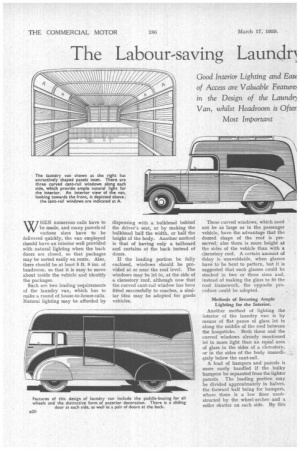The Labour-saving Launcip lan Needs Clever• Design
Page 38

Page 39

If you've noticed an error in this article please click here to report it so we can fix it.
Good Interior Lighting and Ease of Access are Valuable Feature in the Design of the Laundr Van, whilst Headroom is Ofter
Most Important
WHEN numerous calls have to be made, and many parcels of various sizes have to be delivered quickly, the van employed should have an interior well provided with natural lighting when the back doors are closed, so that packages may be sorted easily en route. Also, there should be at least 5 ft. 9 ins, of headroom, so that it is easy to move about inside the vehicle and identify the packages.
Such are two leading requirements of the laundry van, which has to make a round of house-to-house calls. Natural lighting may be afforded by dispensing with a bulkhead behind the driver's seat, or by making the bulkhead half the width, or half the height of the body. Another method is that of having only a tailboard and curtains at the back instead of doors.
If the loading portion be fully enclosed, windows should be provided at or near the roof level. The windows may be let in, at the side of a clerestory roof, although now that the curved cant-rail window has been fitted successfully to coaches, a similar idea may be adopted for goods vehicles. These curved windows, which need not be as large as in the passenger vehicle, have the advantage that the domed shape of the roof is preserved; also there is more height at the sides of the vehicle than with a clerestory roof. A certain amount of delay is unavoidable, when glasses have to be bent to pattern, but it is suggested that such glasses could be stocked in two or three sizes and, instead of making the glass to fit the roof framework, the opposite procedure could be adopted.
Methods of Securing Ample Lighting for the Interior.
Another method of lighting the interior of the laundry van is by means of flat panes of glass let in along the middle of the roof between the hoopsticks. Both these and the curved windows already mentioned let in more light than an equal area of glass in the sides of a clerestory, or in the sides of the body immediately below the cant-rail.
A load of hampers and parcels is more easily handled if the bulky hampers be separated from the lighter parcels. The loading portion may be divided approximately in halves, the forward half being for hampers, where there is a low floor unobstructed by the wheel-arches and a roller shutter on each side. By this
means the heavier part of the load is carried appropriately between the axles.
The rear half of the van has side and back panels, with shelving on each side of a central. gangway. The back is gracefully curved and entrance is afforded by means of a roller shutter and an inside step. The bulkhead between the front and rear compartments is open in the centre so that there is full access between them. When no hampers are carried, the front half of the van may be equipped with side shelving made up as units, which may be quickly removed when not required.
Features of the Laundry Van for Bulk Service.
Large vans are used when the work is that of collecting from or delivering to hotels, ships, and in other instances when hundreds and thousands of articles of linen have to be dealt with expeditiously. A van of suitable type has a pair of doors at the back, opening the full width of the body, also a sliding door on each side.
In order to give the vehicle an attractive appearance, all the wheels can be paddle-boxed. The van may be painted in two contrasting colours, the darker one being used for the sides of the body, between the top of
the driver's door and roof, also for a band which curves over the front
paddle-box and embraces the rear one. This special treatment gives a bold and distinctive appearance to the vehicle.
A simple method of equipping a laundry van when the driver has no assistant is to fit a shell from a half to two-thirds of the width of the body, immediately behind the driver's seat and level with the top of the seat back. This off-side shelf may be 3 ft. or 4 ft. long, or may extend the full length of the body.
It is suggested, however, that there shall be at least half the area of the floor left free, in the event of hampers. or other receptacles of a similar nature having to be accommodated.
This shelf is intended for the more convenient arrangement of the parcels, particularly those which have next to be delivered. Another shelf of similar area may . be mounted. above the one previously described. This arrangement may be modified by making the lower shell the full width of the body.
In such an instance, the :near-side half should be hinged so that it is easily fastened up out of the way when not required, but, when in. use, it allows several packages to be placed within easy reach of the driver. The shelves should have fillets all round to keep the parcels in position, and the corresponding area of the floor should be similarly enclosed.




















































































